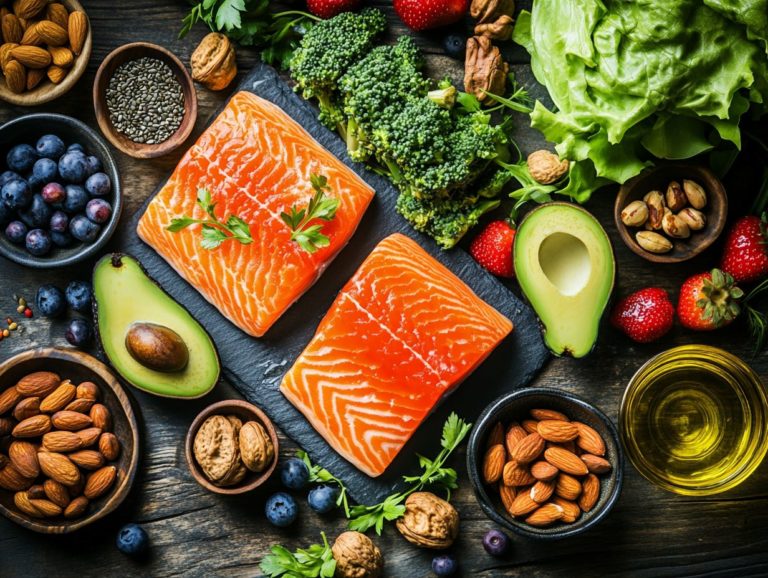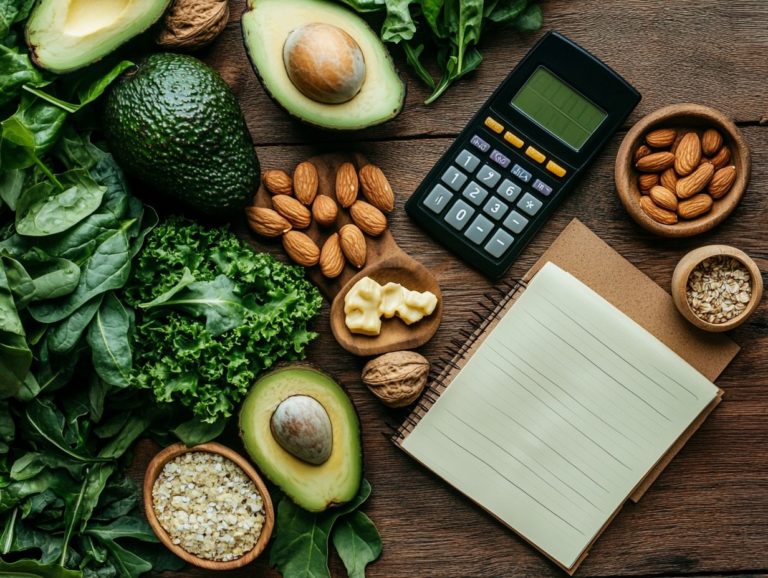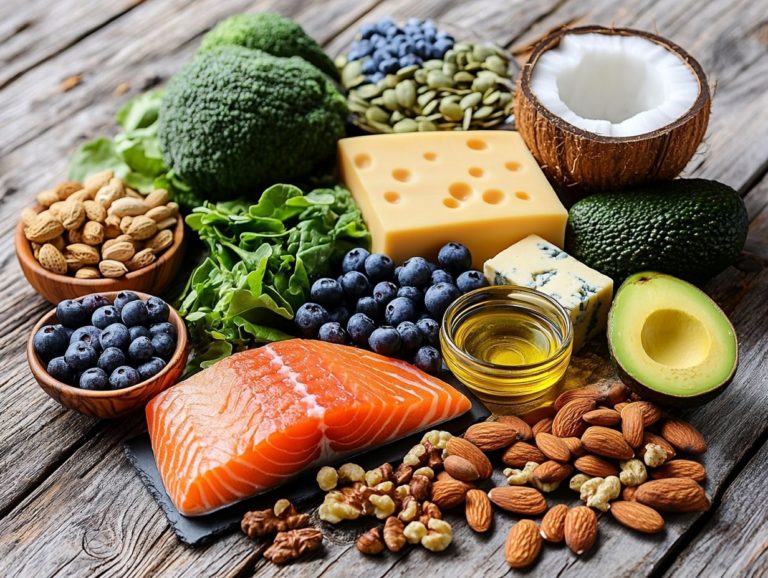Top Nutritional Mistakes on Keto
The Keto diet, also known as the ketogenic diet, has surged in popularity, celebrated for its potential to facilitate weight loss and enhance overall health by helping your body burn fat.
However, navigating this low-carb diet can be quite the challenge, especially when it comes to fulfilling your nutritional needs. Maintaining the right electrolyte balance is crucial.
This guide will take you on an exciting journey through the essential macronutrient requirements, detailing exactly how many carbs, proteins, and fats you should aim to consume on a successful keto journey.
It will also shed light on the common pitfalls you might encounter and offer practical tips to help you stay on track and maximize your success, including how to avoid diet mistakes.
Whether you’re just beginning this dietary path or looking to refine your approach, this guide is tailored for you, with insights from experts like Isadora Baum and Stephen Riggs, MD, MercyOne Kimball Family Medicine.
Contents
- What is the Keto Diet?
- What are the Nutritional Requirements of the Keto Diet?
- What are the Top Nutritional Mistakes on Keto?
- Eating Too Many Carbs
- Not Eating Enough Fat
- Not Eating Enough Vegetables
- Not Drinking Enough Water
- Not Getting Enough Electrolytes
- Not Tracking Macros
- Avoiding Nutritional Mistakes on Keto
- Key Nutritional Strategies for the Keto Diet
- Frequently Asked Questions
- What are the top nutritional mistakes people make on a keto diet?
- Can I consume as much fat as I want on a keto diet?
- Is it necessary to track my macros on a keto diet?
- Can I eat processed keto snacks while on a keto diet?
- Do I need to supplement with electrolytes on a keto diet?
- Is exercise important on a keto diet?
Key Takeaways:
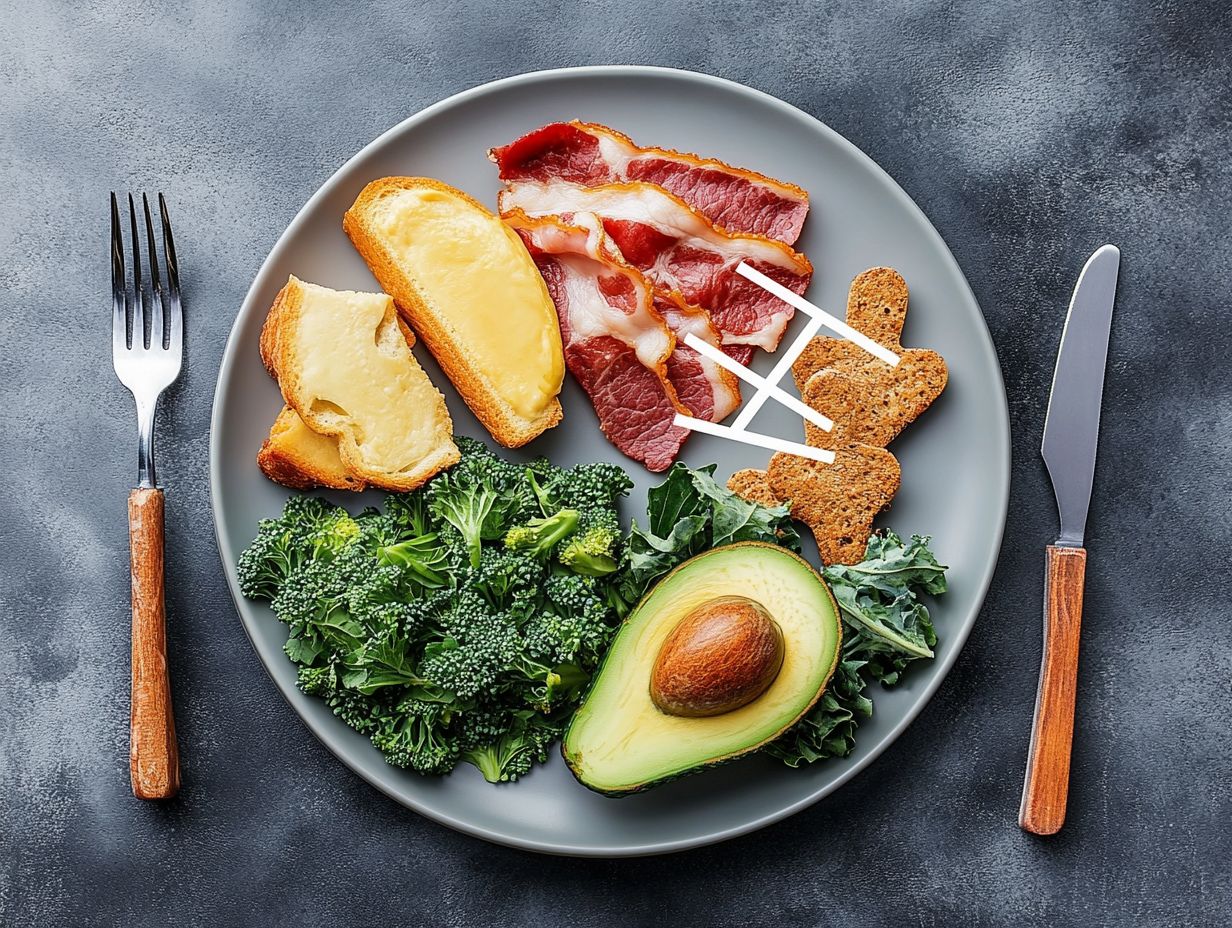
- Not tracking macros with a macro tracker can lead to consuming too many carbs, not enough fat, and not enough calories.
- Planning meals ahead of time, also known as meal planning, and consulting with a registered dietitian can help avoid common nutritional mistakes on the keto diet.
- Hydration and electrolyte intake, along with incorporating a variety of non-starchy vegetables, are essential for success on the keto diet.
What is the Keto Diet?
The ketogenic diet, often referred to as keto, is a high-fat, low-carbohydrate regimen that aims to shift your body’s metabolism from relying on carbohydrates as its primary energy source to utilizing fats instead, often through the use of keto-friendly products.
This transition can lead to lower insulin levels and enhanced management of conditions like Type 2 Diabetes. By drastically cutting back on carbohydrates and replacing them with healthy fats, you encourage your body to enter a metabolic state known as ketosis.
In this state, your body becomes remarkably efficient at burning fat for energy. This shift not only helps with weight loss but also aids in the management of conditions like Alzheimer s, Parkinson’s, and Multiple Sclerosis.
What are the Nutritional Requirements of the Keto Diet?
The nutritional requirements of the keto diet demand your careful attention to macronutrient balance to achieve and sustain ketosis. You ll predominantly focus on high-fat foods while keeping protein intake moderate and drastically reducing carbohydrates typically below 50 grams per day, mostly derived from non-starchy vegetables.
This precise macronutrient ratio is designed to elevate your fat intake to roughly 70-75% of your total calorie consumption. However, it s crucial to ensure that you don t overlook essential vitamins and minerals, as neglecting these can lead to common nutrient deficiencies often associated with a strict dietary approach.
This careful balance is essential for those managing conditions like PCOS and Candida albicans.
How Many Carbs Should You Eat on Keto?
When you embark on the ketogenic diet, you’re typically advised to restrict your carbohydrate intake to 20-50 grams per day. This limit is tailored to your personal health goals and activity levels to effectively achieve and maintain ketosis.
This strict limit on carbs is essential for minimizing insulin spikes while maximizing fat utilization for energy, allowing you to reap the full benefits of the keto lifestyle.
To accurately track your carbohydrate intake, it s vital to read food labels carefully, as they contain crucial information on net carbs that can significantly influence your daily totals. Be aware that many processed foods harbor hidden carbohydrates that can accumulate quickly.
By focusing primarily on non-starchy vegetables, you can maintain lower carb counts while still obtaining the necessary nutrients. Considering sugar alcohols can be a savvy choice; they often contain fewer carbs and calories while delivering a sweet taste to satisfy your cravings without derailing your ketosis.
Ready to start your keto journey? Begin with meal planning and tracking your macros for the best results!
How Much Protein Should You Eat on Keto?
On a ketogenic diet, you should moderate your protein intake to prevent your body from converting excess protein into glucose. Typically, aim for around 15-30% of your total calorie intake, or about 0.6-1.0 grams of protein per kilogram of your body weight. This ensures your body has enough protein to preserve muscle mass and support overall health.
Keeping your body in a fat-burning state that s conducive to ketosis is essential. To achieve this balance, focus on high-quality protein sources that align with the principles of a keto lifestyle. Ideal options include fatty cuts of meat, like ribeye or pork belly, and wild-caught fish such as salmon, which is rich in omega-3 fatty acids.
Eggs and high-fat dairy products, like cheese and Greek yogurt, also provide excellent protein while contributing beneficial fats to your diet. When planning your meals, be mindful of portion sizes to avoid common pitfalls, such as overconsumption of protein that can disrupt your state of ketosis.
Strategically planning your meals around these protein sources while incorporating healthy fats from avocados, nuts, and oils will help you maintain an optimal metabolic state and keep cravings at bay.
How Much Fat Should You Eat on Keto?
In your journey toward a successful keto diet, fat intake becomes paramount, making up about 70-75% of your total calorie consumption. This means you should embrace high-fat foods like avocados, nuts, seeds, and healthy oils to achieve your dietary goals.
Focus on healthy fats, such as monounsaturated fats and omega-3 fatty acids, to enhance your diet. By doing so, you not only fuel your body s energy needs but also improve nutrient absorption and hormone regulation, paving the way for a sustainable ketogenic lifestyle.
Prioritize monounsaturated fats found in olive oil and avocados, along with omega-3 fatty acids from fatty fish and flaxseeds. This will elevate your overall health while maintaining ketosis. Limit undesirable fats, especially trans fats and highly refined vegetable oils, as they can contribute to inflammation and other health complications.
To ensure success, consider your water intake and maintaining proper electrolyte balance. Meal prepping keto-friendly recipes that highlight these beneficial fats makes it easier to stay on track and enjoy delicious meals without the hassle of constant cooking. This approach makes sticking to your keto goals fun and easy!
What are the Top Nutritional Mistakes on Keto?
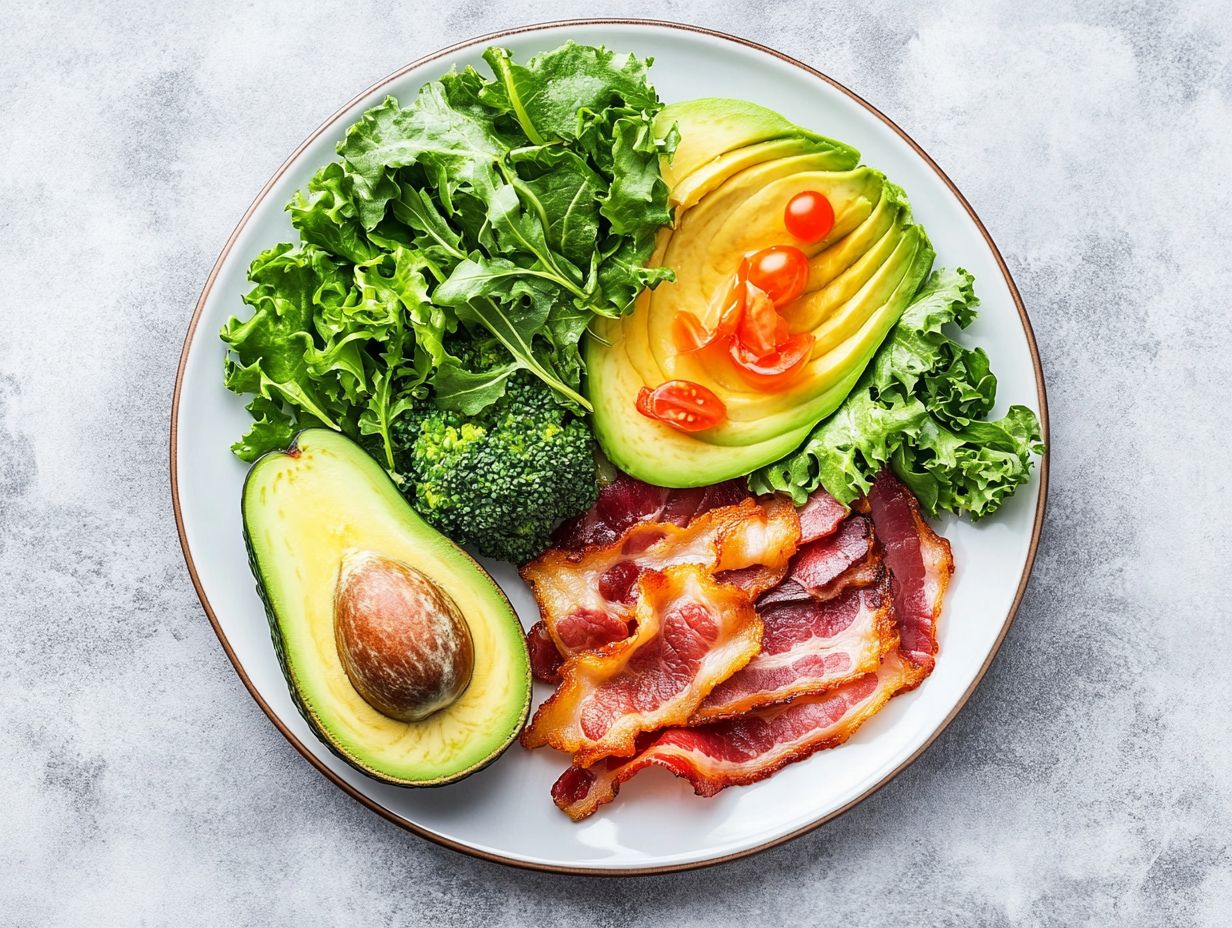
Embracing the ketogenic diet can indeed pose challenges, and many individuals often stumble into familiar nutritional missteps that could undermine their journey. Common mistakes include not consuming enough healthy fats or failing to account for nutrient deficiencies.
You might find yourself inadvertently consuming too many carbs, neglecting the vital balance of electrolytes, or forgetting the importance of staying hydrated. All of these factors can lead to discomfort often dubbed the keto flu. Incorporating a healthy broth into your diet helps mitigate these symptoms.
These common pitfalls not only threaten to derail your progress but also elevate the risk of nutrient deficiencies. Therefore, cultivating awareness and engaging in thoughtful planning, such as meal prepping, becomes essential to fully reap the benefits of the keto lifestyle.
Ready to embark on your keto journey? Try meal prepping this week and share your experiences with others!
Eating Too Many Carbs
One of the most frequent missteps on the ketogenic diet is indulging in too many carbohydrates. This can swiftly derail your journey into ketosis and hinder your ability to reap the full benefits of fat metabolism. You might underestimate the carbohydrate content lurking in foods that seem healthy, inadvertently pushing yourself over your daily carb limit.
To sidestep this common pitfall, it s crucial to make it a habit of spotting hidden sources of carbohydrates, particularly those that tend to hide in snacks and processed items. Granola bars, flavored yogurts, and salad dressings can harbor more carbs than you might expect.
To keep yourself on track, cultivate the habit of scrutinizing labels with care. Pay attention to both the total carbohydrates and fiber content, so you can accurately calculate net carbs (total carbs minus fiber). Whenever possible, favor whole foods like fresh vegetables, nuts, and meats. This approach not only provides clearer insights into carb counts but also encourages healthier choices.
By maintaining this awareness and mindfulness, you’ll greatly enhance your ability to adhere to your carbohydrate limits and thrive on your ketogenic journey. This strategy is vital for managing conditions like Type 2 Diabetes, ensuring you stay on track!
Not Eating Enough Fat
One critical mistake you might encounter on the keto diet is not consuming enough fat. Healthy fats are essential for maintaining your energy levels and achieving nutritional balance. There s a common misconception that all fats should be avoided, but in reality, healthy fats like avocados, olive oil, and nuts should be your primary source of calories.
By incorporating these nutrient-dense foods into your diet, you not only bolster your satiety but also enhance your overall well-being by providing vital fatty acids. For instance, indulging in fatty fish such as salmon and mackerel gives you a generous dose of omega-3s, which are crucial for heart health.
To seamlessly integrate these high-fat options into your daily meals, consider starting your day with a smoothie enriched with avocado or savoring a salad drizzled with extra virgin olive oil.
Snacking on almonds or adding chia seeds to your yogurt can also elevate the fat content without sacrificing flavor. This ensures that your meals are both satisfying and nutritious. Incorporating healthy snacks into your diet can make a significant difference in maintaining your nutritional balance.
Not Eating Enough Vegetables
Neglecting to include enough non-starchy vegetables in your keto diet can lead to nutrient deficiencies and a significant lack of dietary fiber. Both of which are essential for maintaining digestive health. Many individuals following the keto approach often overlook vegetables, mistakenly thinking they are too high in carbs, resulting in an unbalanced intake.
These vital plant-based foods are treasure troves of vitamins like A, C, and K, along with important minerals such as potassium and magnesium. By emphasizing low-carb options like spinach, kale, broccoli, and zucchini, you can enhance your nutrient intake without jeopardizing ketosis. These high-quality foods are essential for a balanced nutritional diet.
Here are some ways to include these vegetables in your meals:
- Adding spinach to your morning omelet
- Roasting broccoli with olive oil and garlic for a delightful side dish
- Creating zucchini noodles as a tasty pasta alternative
By diversifying the array of non-starchy vegetables in your diet, you can ensure that you meet your nutritional needs while fully embracing a keto lifestyle.
Not Drinking Enough Water
Drink up! Staying hydrated is vital for your keto journey. Inadequate water intake is a common misstep for those navigating the keto diet. It often exacerbates symptoms of the infamous keto flu and leads to dehydration.
As you shift into ketosis, your body tends to excrete more water and electrolytes. This makes it essential to elevate your hydration levels to maintain balance and overall health.
To combat this, experts typically recommend that you aim for at least 8-10 cups of water each day, adjusting based on your activity levels and the environment around you.
You can incorporate hydrating foods like cucumbers and lettuce to beautifully complement your water consumption. Additionally, herbal teas provide a delightful alternative that also contributes to your fluid intake.
Broth, particularly from bone or vegetable sources, not only supports your hydration efforts but also delivers essential electrolytes like sodium and potassium. These are crucial in preventing or easing the discomfort that comes with the keto flu.
By maintaining proper hydration, you ensure that your body s processes function at their best. This fosters a smoother and more comfortable transition into ketosis. Including Keto Bars and Fat Bombs can also be beneficial for sustaining energy levels during this phase.
Not Getting Enough Electrolytes
Failing to address electrolyte imbalance is a significant oversight many encounter on the keto diet. This can lead to fatigue, headaches, and muscle cramps, which are symptoms frequently mistaken for the keto flu.
Ensuring adequate intake of electrolytes, particularly sodium, potassium, and magnesium, is crucial for counteracting these effects and maintaining overall well-being as you transition into ketosis. Dr. Stephen Riggs, MD from MercyOne Kimball Family Medicine emphasizes the importance of staying hydrated and balancing electrolytes.
To achieve a proper electrolyte balance, it’s essential to incorporate a variety of electrolyte-rich foods into your daily meals:
- Leafy greens
- Avocados
- Nuts
- Seeds
- A sprinkle of sea salt to elevate your sodium levels
If you find it challenging to meet your electrolyte needs through diet alone, considering electrolyte supplements may be a wise choice.
Paying close attention to your hydration levels and being mindful of signs indicating an imbalance, such as dizziness or muscle twitching, will allow you to make timely adjustments to your intake.
By staying attuned to these factors, you can cultivate a healthier experience on the keto diet.
Not Tracking Macros
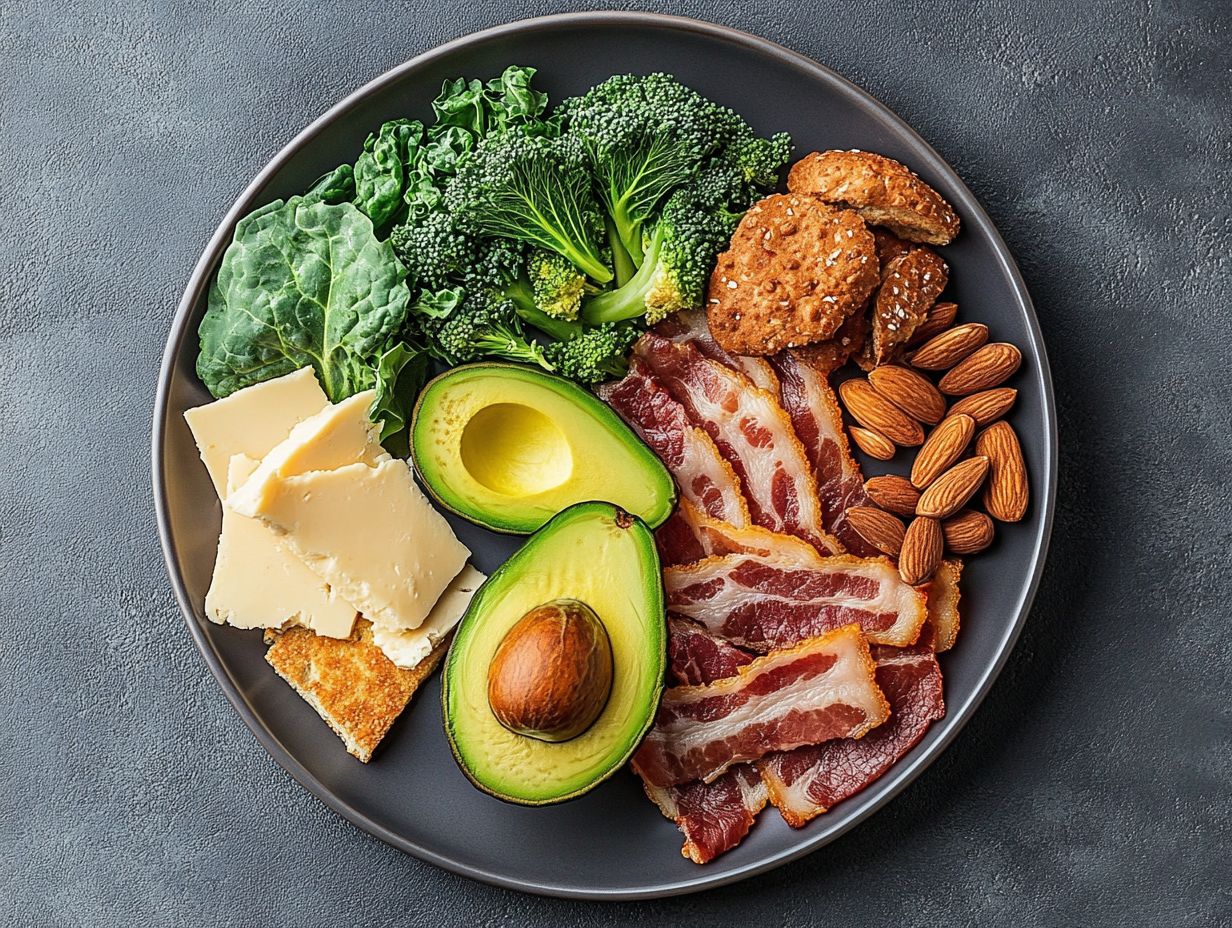
Failing to track macros is a common misstep for those on the keto journey. This can lead to imbalances that impede your path to achieving ketosis and reaching your health goals.
By utilizing a macro tracker, you gain invaluable insights into your daily food intake. This ensures you stick to the recommended ratios of fats, proteins, and carbohydrates.
Isadora Baum, a nutrition expert, suggests that diligent tracking aids in maintaining a balanced and effective keto diet. Incorporating this practice enhances your meal planning and enables you to recognize patterns in your eating habits.
Mobile apps like MyFitnessPal or Cronometer, along with the reliable method of journaling, can make logging your food intake and calculating macros a breeze.
When setting macro goals, it s essential to start with realistic targets tailored to your personal activity levels and dietary preferences. Regularly monitoring your progress allows for necessary adjustments to keep your goals aligned with your evolving needs, fostering sustained motivation.
Take action now! Be proactive in tracking your hydration and electrolytes for better results on your keto journey.
Not Eating Enough Calories
Under-eating calories is a common pitfall on the keto diet, where concentrating on fat and restricting carbs can unintentionally lead to insufficient energy intake. This oversight can result in a decreased metabolic rate and fatigue. It can also hinder weight loss progress.
It s essential to accurately assess your caloric intake by considering factors such as your activity level, age, and specific health goals. If your aim is weight loss, eating fewer calories than you burn can be advantageous. Conversely, if you’re looking to build muscle or maintain your current weight, you may need to eat more calories. High-fat diet foods like avocados, nuts, and seeds can be particularly beneficial in meeting these caloric requirements.
To effectively meet these requirements, opting for calorie-dense, keto-friendly foods will be key.
Incorporating foods like avocados, nuts, seeds, and full-fat dairy will not only provide you with essential nutrients but also help sustain your energy levels throughout the day. Integrating healthy oils like olive or coconut oil can boost your daily caloric intake while keeping your carb consumption in check.
Avoiding Nutritional Mistakes on Keto
To ensure a successful keto journey and sidestep common nutritional missteps, it’s crucial to embrace strategic practices like effective meal prepping, careful tracking of your macronutrients, and maintaining optimal hydration and electrolyte balance. Incorporating high-quality keto products can also aid in achieving a balanced nutritional diet.
By planning your meals, monitoring what you eat, and staying hydrated, you can take charge of your keto journey!
Plan Your Meals Ahead of Time
Planning your meals ahead of time is an essential strategy for achieving success on the keto diet. It helps you avoid impulsive eating and keeps you aligned with your macronutrient goals, steering clear of common pitfalls. By preparing meals and snacks in advance, you gain control over your food intake and empower yourself to make healthier choices.
This proactive approach can significantly streamline your routine, minimizing the chances of reaching for high-carb options when life becomes hectic. One effective way to implement this strategy is through batch cooking, where you prepare multiple servings of various dishes in a single cooking session.
Using containers for portion control not only makes serving sizes more manageable but also simplifies storage and transport. Consider dishes such as:
- Zucchini noodles with homemade pesto
- Egg muffins with spinach and cheese
- Cauliflower rice stir-fry
These are fantastic keto-friendly options that shine when made in bulk, allowing you to savor them throughout the week with ease.
Track Your Macros and Adjust as Needed
Tracking macronutrients is crucial for anyone on the keto diet. It gives you the power to monitor your intake of fats, proteins, and carbohydrates, helping you maintain ketosis and steer clear of common diet missteps. Regularly adjusting your macros based on your personal progress can further amplify the effectiveness of your dietary journey. According to studies published in Frontiers in Nutrition, careful tracking of your macronutrients is associated with better overall health outcomes.
Apps like MyFitnessPal or Cronometer make tracking easy, thanks to their user-friendly interfaces that allow you to log food effortlessly while providing nutritional breakdowns at a glance. If you prefer a more hands-on approach, an Excel spreadsheet can serve as a powerful tool for detailed tracking and customization of your macro targets.
To stay on track, it s essential to regularly review your intake against your weight loss or performance goals, making necessary modifications along the way. For example, if you notice your progress has stalled, a slight adjustment to your carbohydrate intake or an increase in protein can yield impressive results. Maintaining a flexible mindset toward these adjustments is vital for achieving long-term success in your keto journey.
Key Nutritional Strategies for the Keto Diet
Incorporate a Variety of Low-Carb Vegetables
Incorporating a variety of low-carb, non-starchy vegetables is essential for your success on the keto diet. These vibrant veggies provide vital nutrients and dietary fiber while keeping your carbohydrate intake low, helping you avoid those pesky nutrient deficiencies. Not only do these vegetables elevate your meals, but they also contribute significantly to your overall health and well-being. These vegetables can help manage conditions like Type 2 Diabetes, PCOS, and even reduce the risks associated with neurodegenerative diseases such as Alzheimer’s, Parkinson’s, and Multiple Sclerosis.
Consider including leafy greens like spinach and kale, cruciferous vegetables such as broccoli and cauliflower, and the colorful charm of bell peppers. These choices are brimming with vitamins, minerals, and antioxidants that support your metabolic health and reduce inflammation.
Don t shy away from experimenting in the kitchen; it can truly enhance your dining experience. Picture this: roasted Brussels sprouts tossed with olive oil and garlic, or a refreshing salad featuring arugula and sliced avocado. These delicious dishes will excite your taste buds and leave you craving more!
It s also crucial to rotate these vegetables to ensure you re getting a diverse array of nutrients. By regularly incorporating different varieties, you can maximize health benefits and keep your meals fresh and exciting.
Stay Hydrated and Consume Electrolytes
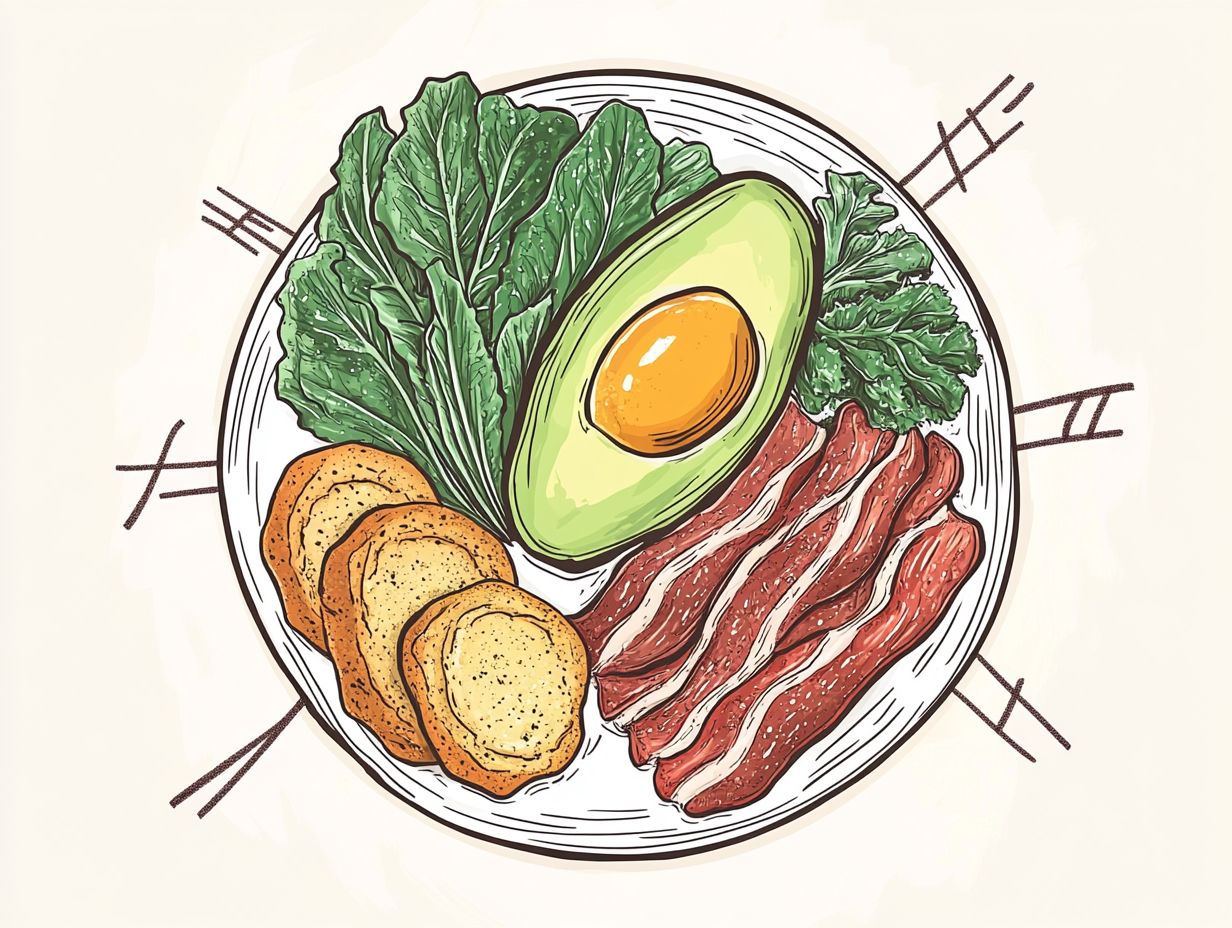
Staying hydrated and maintaining your electrolyte balance is absolutely essential when you’re following the Keto Diet, particularly during those initial phases when your body is adjusting to ketosis. If you re not careful, inadequate hydration can lead to the infamous symptoms of the keto flu. By regularly sipping water and indulging in electrolyte-rich foods, you can alleviate these issues and support your overall well-being!
To elevate your hydration game, think about incorporating beverages like coconut water, which is naturally bursting with potassium, or electrolyte drinks specifically designed for low-carb enthusiasts. Bone broth is another fantastic option; it not only hydrates but also delivers valuable minerals your body craves. These choices are often recommended by health experts like Stephen Riggs, MD, from MercyOne Kimball Family Medicine.
For solid food choices, consider avocados, leafy greens, and nuts as they re excellent sources of essential electrolytes.
Monitoring your hydration levels can be as straightforward as checking the color of your urine or keeping tabs on your daily fluid intake to ensure you re meeting your needs. Pay attention to symptoms like headaches and fatigue they can be your body s way of signaling that it s time to boost your hydration or replenish those electrolytes. Awareness and proactive management are key to navigating your successful keto journey!
For those dealing with conditions like Alzheimer’s and Parkinson’s, hydration and electrolyte balance is absolutely crucial!
Consult with a Registered Dietitian
Consulting with a registered dietitian like Isadora Baum can be exceptionally advantageous as you navigate the intricacies of the keto diet. They offer personalized guidance finely tuned to your unique health needs and dietary aspirations.
A dietitian can help you pinpoint potential pitfalls and ensure that your nutrition needs are fully met, all while steering you clear of meal prep mistakes to avoid on a keto diet associated with the ketogenic lifestyle.
Their expertise lets them evaluate your health conditions and craft a customized keto plan that aligns with your specific metabolic profile, medical history, and lifestyle choices. This professional support is invaluable; it not only boosts your adherence to the diet but also addresses any health concerns that may arise, ultimately leading to more effective and sustainable weight management. Research from EatingWell and Frontiers in Nutrition highlights the importance of personalized dietary plans for better compliance and results.
By collaborating closely with a dietitian, you gain invaluable insights into meal planning, the right balance of fats, proteins, and carbs, and food selections elements that are crucial for maximizing the benefits of a ketogenic approach while minimizing potential risks.
Frequently Asked Questions
Here are some common questions about the keto diet:
What are the top nutritional mistakes people make on a keto diet?
The top nutritional mistakes on keto include not consuming enough healthy fats, over-reliance on processed keto snacks, inadequate vegetable intake, not drinking enough water, not tracking macros properly, and not supplementing with electrolytes.
Can I consume as much fat as I want on a keto diet?
No, while fat is an important part of a keto diet, it’s still important to maintain a calorie deficit for weight loss. Consuming too much fat can prevent weight loss and potentially lead to other health issues.
Is it necessary to track my macros on a keto diet?
Yes, tracking your macros, specifically your fat, protein, and carbohydrate intake, is essential for success on a keto diet. It ensures that you are staying within the recommended ratios for entering and maintaining a state of ketosis.
Can I eat processed keto snacks while on a keto diet?
While there are some healthier options available, consuming too many processed keto snacks can hinder weight loss and potentially lead to nutrient deficiencies. It’s best to focus on whole, nutrient-dense foods on a keto diet.
Do I need to supplement with electrolytes on a keto diet?
Yes, due to the diuretic effect of the keto diet, it’s important to supplement with electrolytes such as sodium, potassium, and magnesium. This can help prevent symptoms of the “keto flu” and ensure proper hydration.
Is exercise important on a keto diet?
While not necessary, incorporating exercise can enhance weight loss and overall health on a keto diet. It’s important to find a form of exercise that works for you and fits your lifestyle, as well as staying properly fueled with keto-friendly foods.
Ready to transform your health? Collaborate with a dietitian today for personalized support! Don’t wait find a registered dietitian near you today!

